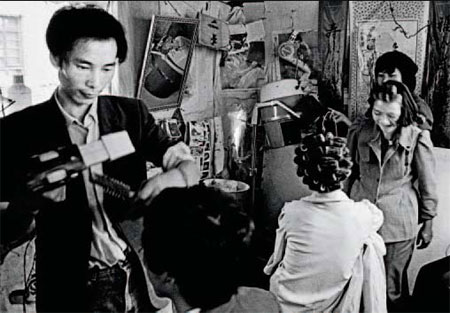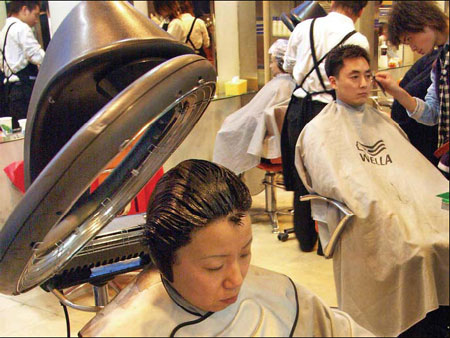All that's hair to stay
Updated: 2012-02-24 08:39
By Echo Zhao (赵蕾) (China Daily)
|
||||||||
今天, 想要惊世骇俗,你要绞尽脑汁才行.但在三十年前, 你只要换个发型就行了.
'Don't hang around these types," a mother would warn her son in the 1980s whenever a young man walked by with his flowing mane trailing in the wind. A longhaired man was a freak, a rebel, something strange and dangerous when all the good boys kept their hair neatly shorn.
|
|
Back in 1927, a newspaper reported that a father severely punished his daughter for cutting her hair. He ordered her to write a confession and place it, along with her sundered braid, in front of the ancestral plaques in their home.
In 1991, the first Wiry Hairdo, radiating outward from my cousin's head, came into my house. The fashionable coiffure didn't stay long. Cousin ran out in tears when Father scolded, "What did you do to your hair? It's too ugly."
Hair, those seemingly innocuous strands atop your head, has raised much ire in China's long history. From the chopping off of men's long braids at the end of the Qing Dynasty (1944-1911) to women making waves with chemical "perms" in the 1980s, hairstyles have been making statements loud and clear.
Creative hairstyles started blossoming in 1979, with the reform and opening-up policy. In the preceding decades, function trumped form as men and women stuck with practical hairdo's that went with the times.
In the 1950s and 1960s, braids (麻花辫 máhuābiàn), a traditional Chinese look, were popular for girls. To show extra revolutionary spirit, married women usually wore their hair in "Liu Hulan" style (刘胡兰头 Liú húlán tóu), named after the martyr who was guillotined at 15 for refusing to surrender. (To create your own "Liu Hulan", brush your bangs off the forehead and tightly secure them to the side with hairpins.)
Men added little to the hair scene during this and earlier times - they were too busy singing songs about the allure of shiny black braids, and, later, about the revolution.
|
|
But once China began opening up, girls unleashed their imaginations. Long-fettered vanity came out to play. More and more braids were invented: plain braids, inverted braids, three-, four-, six-strand braids. A nationwide fashion face-off started as women tried to outdo each other with intricate hair handiwork.
Where there is fashion, there are throwbacks. The perm, first seen in 1930s Shanghai, made a comeback in the 1980s. Perming methods were still rudimentary - sometimes fire-tongs wrapped in a wet towel did the trick - making curly hair a thrilling look in more ways than one.
"Slight carelessness would get you burnt hair," Barber Wang recalled. "But our business was incredibly good."
Some shops had started using chemicals, but they were the toxic stinky kind. Women were braving it - burns, stench and all - just to follow hair fashion. I already alluded to the "Wiry Hair" (钢丝发 gāngsī fà) episode at my house, but there were many other popular looks.
In the early 1980s, the "Wave Hair" (招手停 zhāoshóu tíng) set a milestone in Chinese hair history; it was the first named hairstyle. The"wave" was made by lifting bangs high when they dried and then coaxing them into shape with the help of imported hair mousse.
After the "Wave Hair" came lots of monikered styles, which were increasingly varied.
Hong Kong singer Zhang Qiang (nicknamed the Chinese Disco Queen) burst onto the scene with her Afro-style "Exploding Hair" (爆炸头 bàozhà tóu).
Hong Kong and Taiwan TV shows infiltrated the mainland, making girls covet the center-parted long straight hair of Brigitte Lin (林青霞 Lín Qīngxiá). For extra coyness, girls mimicked Brigitte by tucking a flower behind the ear.
Men were initially shy about jumping on the hairstyling bandwagon. Through the 1980s, the "Xiaoping crew cut" (小平头 Xiǎopíng tóu) was standard, favored for its short length and as a tribute to our leader Deng. There was little variation in men's coiffures.
But this all changed when the Four Heavenly Kings of Cantopop (四大天王 Sì Dà Tiānwáng) came onto the entertainment scene in the 1990s. Young men flocked to shape their locks into the "Aaron Kwok Hairstyle" (郭富城头 Guō Fùchéng tóu), a longer middle-parted look.
Other favorites were the "Jimmy Hair" (林志颖头 Lín Zhìyǐng tóu), inspired by Taiwanese star Jimmy Lin, and the "Cheng Yee Kin" (郑伊健 Zhèng Yìjiàn), a shaggy long do worn by a Hong Kong celebrity. For an extra dose of trendy rebellion, some men also curled their long hair.
From the 1990s onward, the business of hair grew. Barbershops and salons sprang up everywhere. Products and shampoos flooded the market. The Big Three (Head & Shoulders, Pantene and Rejoice) dominated the Chinese market and flashed unprecedented advertising campaigns at everyone with moldable strands.
In this era, too, modern Chinese no longer saw choice as a novelty. Individualism in fashion grew; the fervent trend following of the 1980s subsided. No single look would elevate to iconic hairstyle status with so many now competing for attention.
By the time we crossed the millennial mark, it was already a matter of fact that hair is something to be played with, innovated and reinvented. Length and straightness are just two variables in the hairstyle formula. Color, texture and sheen are all ways for people to differentiate their hair from that of a billion and a half other people's. Currently, "The Bob" (波波头 bōbō tóu) is drawing a female fan club, but each girl puts her own spin on the short blunt style. Most Bob experiments turn out well, but the strangest ones are at least as astounding as the "Wiry Hair" that graced my home two decades ago.
Surely, switching up your hairstyle will become easier and easier in the years to come. But, perhaps the biggest change of all in Chinese hair history is that new styles no longer elicit fury. After seeing so many strange heads, the elderly are no longer so easily fazed.
Courtesy of The World of Chinese, www.theworldofchinese.com

 Relief reaches isolated village
Relief reaches isolated village
 Rainfall poses new threats to quake-hit region
Rainfall poses new threats to quake-hit region
 Funerals begin for Boston bombing victims
Funerals begin for Boston bombing victims
 Quake takeaway from China's Air Force
Quake takeaway from China's Air Force
 Obama celebrates young inventors at science fair
Obama celebrates young inventors at science fair
 Earth Day marked around the world
Earth Day marked around the world
 Volunteer team helping students find sense of normalcy
Volunteer team helping students find sense of normalcy
 Ethnic groups quick to join rescue efforts
Ethnic groups quick to join rescue efforts
Most Viewed
Editor's Picks

|

|

|

|

|

|
Today's Top News
Chinese fleet drives out Japan's boats from Diaoyu
Health new priority for quake zone
Inspired by Guan, more Chinese pick up golf
Russia criticizes US reports on human rights
China, ROK criticize visits to shrine
Sino-US shared interests emphasized
China 'aims to share its dream with world'
Chinese president appoints 5 new ambassadors
US Weekly

|

|








